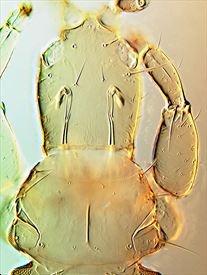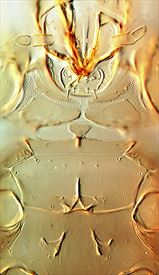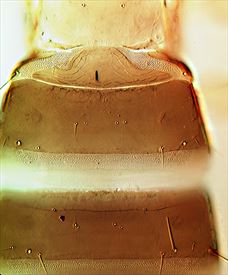Distinguishing features
Both sexes usually wingless. Body brown, sometimes paler on head and thorax; tube dark brown in basal two-thirds, paler distally; femora usually brown, sometimes yellow; tibiae and tarsi yellow; antennae brown, but segments III–V yellow at base; major setae pale; fore wings (when present) fuscous. Head elongate, projecting in front of eyes; cheeks slightly convex; dorsal surface sculptured laterally; ocelli reduced; postocular setae finely acute, longer than distance between compound eyes; maxillary stylets separated by about one-third to one-half of head width, retracted into head as far as postocular setae; maxillary palp first segment longer than second segment. Antennae 8-segmented; segments VII and VIII not closely joined; III with 2 sense cones, IV with 4. Pronotum weakly sculptured posteriorly; major setae long, fine, epimeral and posteroangular pairs longest; epimeral sutures complete. Basantra, mesopresternum, and metathoracic sternopleural sutures present. Fore tarsal tooth absent. Pelta with median lobe not pronounced but bearing broad lateral lobes; tergite IX setae acute, about as long as tube; tube with straight sides. Female macroptera with ocelli well developed and eyes larger; fore wing with 7 or 8 duplicated cilia; tergites III–VI each with a pair of wing retaining setae; abdomen with pelta bearing a pronounced median lobe.
Male similar to female aptera but smaller; fore tarsal tooth present, variable in size.
Related species
There are 23 species listed in this genus, mainly from Australia and the Pacific Islands (Eow et al., 2015). These species are unusual in having the basal segment of the maxillary palps longer than the second segment.
Biological data
Feeding on fungal spores, and breeding in leaf litter.
Distribution data
Widely distributed in New Zealand (Three Kings Is / ND, AK, CL, BP, TO, TK, WN / SD, NN, BR, WD, MC, MK, CO, DN, SL, FD), but presumably originally from Australia where it is widespread in leaf litter of the eastern moist forests as far north as Cape Tribulation, and has also been taken on Lord Howe Island.
Family name
PHLAEOTHRIPIDAE, IDOLOTHRIPINAE
Species name
Carientothrips loisthus Mound
Original name and synonyms
Carientothrips loisthus Mound, 1974: 29
References
Eow LX, Mound LA, Tree DJ & Cameron SL (2014) Australian species of spore-feeding Thysanoptera in the genera Carientothrips and Nesothrips (Phlaeothripidae: Idolothripinae). Zootaxa 3821 (2): 193–221.
Mound LA & Walker AK (1986) Tubulifera (Insecta: Thysanoptera). Fauna of New Zealand 10: 1–140.



